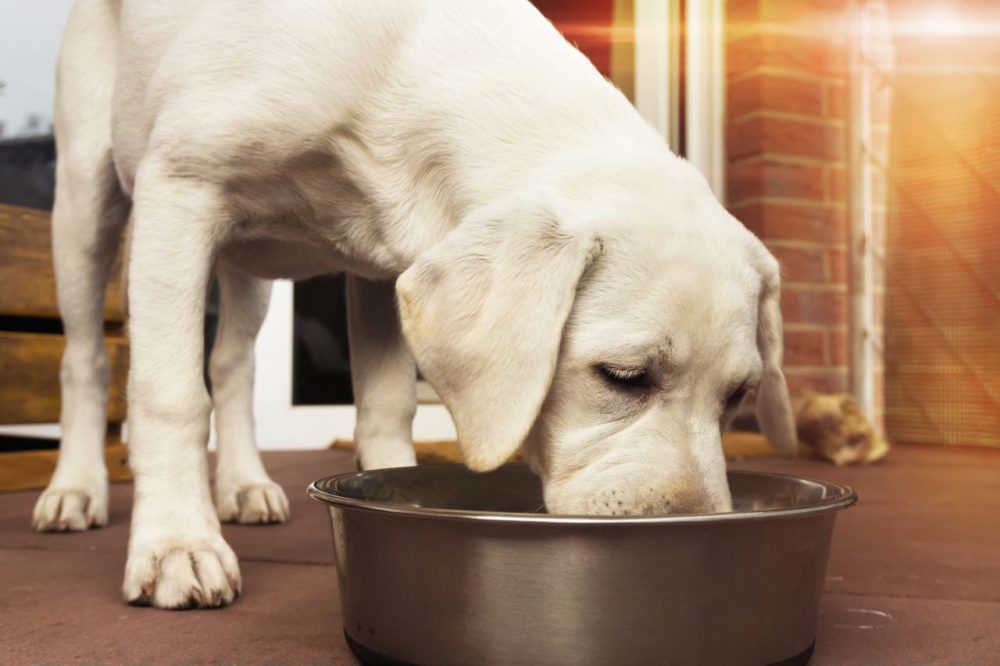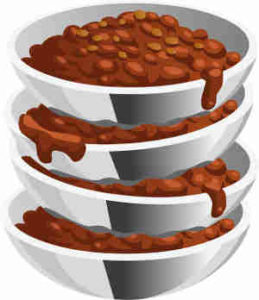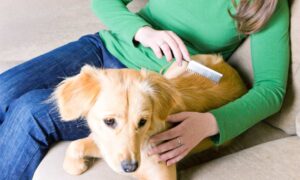This article at a glance
- Puppies require high protein dog food for growth and health
- Don’t overdo the amount of protein in your dogs meal and watch out for the calories
- Watch out for low quality protein in canned dog food
Conclusion: High protein food can be part of your dogs diet, but be sure to balance it out with other products
Dogs truly are a man’s best friend but they also are a great responsibility for their masters. Apart from feeding them and cleaning them daily, dogs require plenty of affection, love, time and daily long walks. They truly are a commitment right from upon their birth but, if treated accordingly, they can grow to become best companions to humans.
Dogs are extremely intelligent also and can learn a large array of commands and tricks and can also be taught to look after persons in need – from children with autism to people recovering from surgeries, depressions, or people who are partially or totally blind.
But looking after your dog also means offering them the best and healthiest nutrition daily. Direct descendants of wolves, dogs must base a large number of their diets on protein and carbohydrates to give them enough power and energy for running and being active all day long. Thus, high protein puppy food is a must if you want to grow a healthy and active dog.
Do dogs need high protein food?
Unlike felines who are mainly carnivores, dogs, just like humans, are omnivorous animals, meaning they can survive both with meat and food of plant origin. However, there is a great difference between surviving and thriving. In order for your dog to grow big, strong, and healthy, the protein of animal origin should be daily included in his diet. In other words, dogs should definitely receive meat on a regular basis.
And although dogs could also receive a high amount of vegetal protein from grains and mainly corn, diets based on corn are most of the time inefficient and even dangerous for your friend with paws. On the other hand, a diet solely based on meat could be hazardous too. The key to a healthy diet providing all minerals, vitamins, and protein necessary to your dog is moderation and variation.
You can serve your dog pretty much everything (except for a few fruits and veggies and processed food) but in small amounts. Teach your dog to eat at regular hours and avoid feeding him snacks apart from once a day and only if necessary. How much protein your best friend needs, depends on his own habits and the manufacturer’s product.
A dog, just like humans, cannot survive solely on one type of food no matter how delicious it is. Thus, giving your dog on regular occasions a protein-rich wet dog food or canned food should be out of the question. Dogs require real food and can have almost everything their owners eat (except for when the owners are vegans.
We already mentioned a dog can survive on vegetable and vegetal-original aliments but you shouldn’t do this experiment). However, bear in mind that your dog likes variety in his meals as well, so try integrating this in your dog’s daily diet routine different animals.
What dogs can eat?
As previously mentioned, dogs are similar to humans, meaning they are omnivorous. Here is a list with the most common types of aliments you can integrate into your dog’s daily diet.
• Meat by-products: liver, spleen, intestines, liver, kidney
• Raw meat: lamb, beef, chicken, turkey, duck, salmon, herring, tuna
• Dairy products (with moderation and only cooked): eggs, milk, cheese
• Grains: corn, wheat, oatmeal, soy, rice, barley
• Fibers
• Nuts and seeds
• Fruits and vegetables
Most dry dog food is rich in corn and grains which is not entirely healthy for your dog. Although cheaper, corn is usually genetically modified and can cause a wide series of health problems to your dog if consumed daily. Corn and grains, in general, are a great source of carbohydrates that your dog requires to get energy.
However, extra carbohydrates in the system lead to deposits of sugar and fat which, apart from obesity, can lead to a series of other health affections, including high blood pressure, cardiovascular diseases, and diabetes.
Thus, before deciding to offer your dog a diet rich in grains (mainly in the form of dry food bought from regular stores or pet shops), you should think twice. Dogs are supposed to thrive on meat, the real meat, and not necessarily on corn and vegetables.
Sure, veggies and fruits are a rich source of vitamins, fibers, and antioxidants, but dogs can live without that. Meat also offers vitamins apart from protein, and the right ratio for a healthy dog diet should be around 70% animal protein and 30% fresh food (including veggies, some fruits, and grains).
This is what you should look for when going through the numerous brands offering their product on the dog food market. On the label you can find the exact formula of each product, so be sure to check it out thoroughly. Look for a product that has a selection of some of the finest quality ingredients in its formula.
Elsewhere on this site we have some good reviews on products from well-known brands as Exceed, Diamond and Natural Life. You can find their products on Amazon or Ebay and they offer free shipping if your order a certain amount. Be sure to also check out their prices and compare them, there could be a real bargain out there for you.
So what should you feed your dog with?
There are numerous types of dog food on the market, depending on your budget, expectations and (lack of) care for your dog’s health. Although a diet mainly based on real meat and not cans or corn is ideal, it is quite costly and takes a lot of time to prepare, especially on the long term.
This is why most dog owners choose to give their dogs dry or wet food, premixed, and processed from more or less known dog food producers worldwide. The complete food is extremely popular as they provide all the right nutrients to keep the dog healthy. They can come in three different forms – wet, dry or raw.
However, the most popular remains the dry food which can be made using various procedures, from baking to air drying and extrusion. However, most of them are extremely rich in cholesterol and carbohydrates as they are mainly based on corn and grains.
Raw food also present a series of downsides, especially regarding storage and transportation. Although more natural choices and with an increased popularity by the day, raw food are inconvenient when travelling or vacationing. Also, if you live in hot and humid areas, you may risk your raw food will alter easier. Moreover, raw and uncooked food, especially meat can become a series health threat to your dog.
When to feed your dog?
Another great problem emerging with most of dog owners is the inability of maintaining a strict diet plan for their dog. Owners are either too permissive or don’t provide sufficient food to their dog, according to their age, lifestyle and breed. However, it is not necessarily how often you choose to feed your dog, but how much is the real problem. Some dog owners choose to feed their dogs between 1 and 3 meals per day.
However, most dog owners choose a free feeding system, meaning quantifying the amount of food to be displayed in the dog’s bowl throughout the day. Basically, free-feeding means your dog chooses when to eat throughout the day, depending on his activity or biorhythm.
Feeding your dog the right amount of food is crucial, especially when it comes to high protein dog food, whether it is the grain-free or low-fat version. Thus, it is important to talk to a veterinarian and adjusting the amount of food your dog receives daily depending on his likelihood to go outside and spend his energy running, playing, or in an open environment.
Moreover, it is also extremely important for your dog to learn that once the quantity of food in his bowl is gone, he will not be receiving anything else until the next day. Use treats only to reward a good deed or learning a new trick and do not get soft on those “puppy eyes” or else you will risk overfeeding your dog easily.
Also, if you are used to eating in the same time with your family and dog, make sure your other family members do not feed the dog under the table as the dog needs to learn the difference between man food and his own.
Changing feeding habits
But what can a dog eat aside from meat? Basically pretty much everything, as long as it is not too sweet, doesn’t contain chocolate, caffeine, alcohol or other harmful substances. Sure, a chocolate bar may not harm your dog on the long term, but you might experience a hyper dog on the short term. Grapes are extremely toxic to a dog and shouldn’t be fed under any circumstances. Other fruits like strawberries should be avoided because they can cause allergic reactions, similar to soybeans or nuts.
But feeding your dog the same thing daily might drive him nuts, just like it would do to a human. Have you ever considered eating the same canned food, three times a day, for two-three years in a row? This is why diversity is extremely important to dogs, as it is to humans. But before introducing new food elements to your dog, you should know that this is a gradual job.
Do not jump on offering your dog all kinds of fresh fruits, veggies and home cooked dishes if he was solely on dry food before. Try introducing a new food element at a time, and notice carefully the reactions of your dog over a week. Watch closely for any signs of bad health, food poisoning, allergies or other symptoms that might lead to the conclusion that a certain aliment is harmful to your dog’s health system.
This also comes in handy when you are trying to switch types of meat or replace the main source of protein from your dog’s food.
Is a high protein canned meal healthy?
Although meat should be the primordial source of protein for your dog’s diet, many dog canned food manufacturers choose to cheaper alternatives of protein to add into their products.
This often comes in the shape of soy meal, maize gluten or vegetable protein which are harder to digest by your dog and may lead to further health affections. Most adult dry foods have around 30% of protein intake but, unfortunately, a high percentage comes from lower quality protein sources such as the ones contained by grains.
In order to maintain your dog healthy, vivacious and happy all the time you should consider higher quality protein sources or, in other words, meat under any forms, unprocessed. On top of that, the other ingredients of the dog food should be chosen in such a way that they meet the requirements of your dog. A puppy for instance has different protein needs for its food then a senior dog.
The risks of a high protein regime: itching, hyperactivity and others
Two of the main risks or side effects associated with feeding large amounts of protein are itching and hyperactivity. The first must be taken serious, the latter one can be categorized as myth. Some dogs can have a light allergic reaction to too much protein. As with everything, follow the ratio and observe how your dog reacts to different amounts of protein. In over 95% of the cases, there should be no problem at all. Another often heard complaint about this kind of dog food is hyperactivity.
This can be catalogued as being a myth. Especially puppies needs lots of energy for running around all day. It is known that for instance pitbulls just cannot have too much protein to provide them with the energy they need.
Some other dangers that are sometimes associated with too much protein are diarrhea, gas (flatulence), anxiety, aggressive behaviour and in very rare cases kidney or liver problems. Anyway, the summed up causes of negative side effects do not outweigh the positive added value of high protein food in your dogs diet. It is the perfect food for weight gain and muscle gain of your puppy!
But, as with all good things, excess mainly leads to flaws rather to perfection. Feeding your dog excessive amounts of protein can lead to numerous health conditions as well as overweight or obesity, regardless of the age or breed of your dog. Those, owners should definitely regroup towards low calorie dog food as they are able to offer the optimum levels of protein for your dog without the extra calories that lead to overweight or additional health issues.
But how do you establish the perfect ratio between calories and protein? It mainly depends on your dog’s age, breed and lifestyle. Puppies require a lot of protein as their bodies are constantly growing and developing. They also require special amounts of omega-3 and omega-6 fatty acids, as well as potassium and calcium for proper development of bone structure and healthy teeth growing.
Breed comes secondly when balancing your dog’s protein intake. A pup from different breeds definitely requires an adjusted amount of protein depending on its size. You cannot feed a large pup like a German Sheppard or a Golden Retriever the same amount of protein as you would feed a Chihuahua or a Pomeranian.
What are the alternatives?
Img Source: ltkcdn.netMilitating for a balanced dog diets routine should definitely mean choosing the right alternatives when it comes to dog food. Although canned and dry food could represent easy meals and often equipped with the necessary amounts of vitamins and protein, they can also be quite harmful if fed for a long period of time. Most of the food marketed as canned or dog food is often full of chemicals and preservatives, as well as taste enhancers to taste more deliciously and turn your dog into an addict.
However, on the long term these types of products, although containing the necessary amount of protein, are also rich in empty calories and fats which are harmful and can create serious health problems.
Under these circumstances, appealing to homemade alternatives seems like the best and most viable solution.
Why not spend some time and cook dinner for your dog instead? After all, you do save money by cooking your own meals and not eating outside three times a day, so why not cook for your dog as well? You can easily bake sweet treats and snacks for your dog with foods you already have inside your kitchen, without spending a fortune on store snacks and treats.
Simply be careful at the list of ingredients you choose to cook and your dog should be blessed with homemade treats, crispy cookies and delicious snacks. Not to mention you would literally save big amounts of money.
Peanut butter, bacon and rye flour are common ingredients and, to be honest, quite Americans as well. Look online for recipes to easily integrate these ingredients into your dog’s homemade biscuits and treats and your dog will certainly thank you for it.
Peanut butter and bacon represent rich foods in calories and protein so you might want to lower down the quantity of biscuits or treats you provide your dog with on a daily basis. However, you can still replace a full meal with some of these treats or use regular meat (preferably chicken or turkey breasts) for more nutritional and delicious dog recipes.
If your really insist on buying high protein dog food, for instance because you lack the time to prepare it yourself, we recommend to keep things as naturally possible. For that reason, the best choices in our opinion are Nature’s Recipe and Natural Life. They both have some excellent products, very rich in protein, but still keeping the right balance in the dog food.
Conclusion
Looking after your dog’s diet should be one of your number one priorities if you engaged into sheltering one or more of these animals. Pets diets should be strict and permissive in the same time, favoring diversity and strict meal hours.
Moreover, you should try personalizing your dog’s diet based on his behavior, breed, sex, age and ideal weight. This way you will make sure your dog receives the perfect and most balanced amount of protein, minerals, vitamins and fibers to ensure a healthy growing and a strong body.
All in all you should keep in mind that dogs require a diet mainly based on protein from animal sources and you should avoid corn and grain-based dog food. Replace these inferior sources of protein with the ones directly derived from meats. Steaks, breaks or legs should be the main parts of animal meat your dogs consume to ensure a maximum intake of protein and minerals.


















